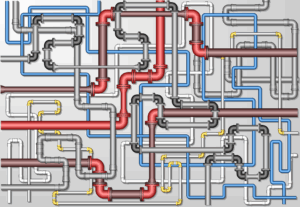With user experience a growing focus, the UX specialist or department can be positioned with or alongside innovation teams, and break the “silo” mentality, which is often prevalent in organizations, whether larger companies or smaller businesses. These specialists can work cross-collaboratively to bring new ideas and products to market. This is especially important in terms of getting closer to the customer, influencing management, conducting user research and enriching the customer value of the initiative.
Be An Influencer
By focusing on customer value, the UX specialist can get everyone on the same page, and bring innovation to the forefront of an organization. Kevin Philpott, Head of User Experience at Pie Insurance, discusses in a Forbes article, “Nine Ways UX Can Turbocharge Innovation,” several tactics that UX can leverage to foster cooperation within a company, bring a design approach, and take innovation efforts to the next level:
- Company-wide communication of the importance of innovation. UX should work hand-in-glove with top management to signal to the entire company the importance of innovation.
- Form cross-functional teams. UX should work with top management to set up cross-functional teams with the flexibility to operate outside the norms of the status quo. Such teams typically have executive support and buy-in to not just conceptualize but actually implement ideas.
- UX can nurture the generation of new ideas. This can be as simple as setting a corporate innovation objective and asking anyone in the organization to email ideas to a suggestion inbox.
- Build in the capacity for innovation. Challenge your UX team to systematically build in the time to innovate during the discovery phase of a design process.
- Move fast and be brave. As advocated by Timothy Clark, innovation requires a culture of intellectual bravery. UX must encourage challenging the status quo. This can be done through brainstorming, encouraging debate or advocating for truly new and differentiated experiences.
- Incentivize innovation. UX teams can also reward innovation by publicly recognizing individuals who have brought new products to market. This recognition could be a widely shared case study or awards for remarkable efforts. UX should also partner with the rest of the organization to incentivize team members in other ways, including bonuses, equity, promotions, time off or providing greater autonomy.
- Evangelize a culture where innovators have permission to fail. Employees must feel safe taking calculated risks.
- Set realistic ROI expectations. Being realistic about the time needed to see results can avoid potential disappointment that could otherwise cancel your innovation program.
- Help manage the innovation process. UX should solicit ideas, conduct discovery to refine ideas and work with other groups to decide which ideas move forward. As experts in product design, UX can collaborate with other departments to assess the expected business value and level of effort in order to better prioritize ideas.
Creating Synergy
In a post on All Things Insights, we explored the topics of CX and UX. Customer experience (CX) is the impression your customers have of your brand based on all of the interactions they’ve had with your business. User experience (UX) is specific to how people use and perceive your products. Why does the difference between these two experiences matter? Specifying between internal roles and responsibilities is key. The UX team needs to focus on enhancing product usability. Meanwhile, a positive brand experience is the significant mark of CX. Separate but integrated strategies could be the difference between success and failure on these two interrelated fronts.
Seth Adler of All Things Insights also recently had a chat with Shilpi Sinha, UX Researcher, Pandora Group, on UX Insights. Sinha further explores the role of UX on the team, and the importance of cross-organizational collaboration. There are myriad teams that have and can provide insight into a given subject. Without each account, there cannot be a full picture of what might be true. And still, when that full picture is provided, a well-constructed team must know how to harness the art of insights into cogent decision making.
Bringing It All Together
Both UX and CX can help marketers improve the customer experience by providing data-driven insights into how customers are engaging with innovation. Through UX research, marketers can identify user needs, behaviors, and preferences that inform the design of a product or service. By understanding these factors, they can tailor experiences to meet users’ expectations and create more meaningful connections with their customers. To focus on the UX component, according to ChatGPT, through research and feedback marketers and insights teams can support the customer in several ways.
- Increase usability: UX design can help customers easily navigate the product, understand how to use it, and complete tasks quickly and efficiently.
- Personalize the experience: UX designers can create personalized experiences tailored to different customer needs and preferences.
- Make it easy to find information: Good UX helps customers find what they’re looking for quickly by creating intuitive navigation systems that are easy to access from any page of the website or app.
- Build trust with customers: By designing an experience that is consistent, reliable, and transparent, businesses can build trust with their customers which leads to greater loyalty.
- Offer a unique design: A unique design will make your product stand out from competitors and give users something special that they won’t find anywhere else – making them more likely to stay engaged with your brand.
Change-Makers
Driving innovation can and should be a cross-team mission for any organization. UX designers and product designers are well positioned to take up this task. As Goran Paun discusses in the article, “How UX Design Can Inspire Innovation,” growth begins with the user. In other words, taking a design centered, user-first approach will benefit the experience, tap into the emotion of the user and help define your brand. As Paun notes, “Innovation and transformation cannot occur without the user and an organization willing to shift their focus on the experiences they wish to create for them.”
Video courtesy of AJ&Smart
Contributor
-

Matthew Kramer is the Digital Editor for All Things Insights & All Things Innovation. He has over 20 years of experience working in publishing and media companies, on a variety of business-to-business publications, websites and trade shows.
View all posts



























































































